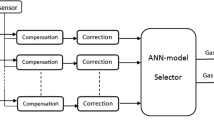Abstract
In this study, an E-Nose system was realized for the anesthetic dose level prediction. For this purpose, sevoflurane anesthetic agent was measured using the E-Nose system implemented with sensor array of quartz crystal microbalances (QCM). In surgeries, anesthetic agents are given to the patients with carrier gases of oxygen (O2) and nitrous oxide (N2O). Frequency changes on QCM sensors to the eight sevoflurane anesthetic dose levels were recorded via RS-232 serial port. A multilayer feed forward artificial neural network (MLNN) structure was used to provide the relationship between the frequency change and the anesthetic dose level. The MLNNs were trained with the measured data using Levenberg–Marquardt algorithm. Then, the trained MLNNs were tested with random data. The results have showed that, acceptable anesthetic dose level predictions have been obtained successfully.







Similar content being viewed by others
References
Marshall, B. E., and Lockenfger, D. E., General anaesthetics. Goodman and gilman’s, the pharmocological basis of therapeutics, 8th Edition. Permagon Press, pp. 285–311, 1990.
Snow, J. C., Manual of Anesthesia, 2nd edition. Little, Brown and Company, Boston, 1982.
Saraoglu, H. M., Sanlı, S., Fuzzy logıc based anesthetic depth control, 2003 ICIS International Conference on Signal Processing (ICSP 2003), September 24–26. Çanakkale, Turkey, 2003.
Mahfouf, M., Asbury, A. J., Likens, D. A., Unconstrained and constrained generalized predictive control of depth of anesthesia during surgery. Control Eng. Pract. 11:1501–1515, 2003.
Becker, K., Thull, B., Kasmacher-Leidinger, H., Stemmer, J., Rau, G., Kalf, G., Zimmermann, H., Design and validation of an intelligent patient monitoring and alarm system based on fuzzy logic process model. Artif. Intell. Med. 11:33–53, 1997.
Vefghi, L., Linkens, D. A., Internal representation in neural networks used for classification of patient anesthetic states and dosage. Comput. Methods Programs Biomed. 59:75–89, 1999.
King, W. H., Piozoelectric sorption detector. Anal. Chem. 36–(9):1735–1739, 1964.
O’Sullivan, C. K., Guilbault, G. G., Review commercial quartz crystal microbalances—theory and applications. Biosens. Bioelectron. 14:663–670, 1999.
Temurtas, F., Tasaltin, C., Temurtas, H., Yumusak, N., Ozturk, Z. Z., Fuzzy logic and neural network applications on the gas sensor data: concentration estimation. Lect. Notes Comput. Sci. 2869:179–186, 2003.
Gulbag, A., Temurtas, F., A study on quantitative classification of binary gas mixture using neural networks and adaptive neuro fuzzy inference systems. Sens. Actuators B 115:252–262, 2006.
Yusubov, I., Gulbag, A., Temurtas, F., A study on mixture classification using neural network. Elec. Lett. Sci. Eng. 3(1):44–49, 2007.
Jang, J.-S. R., Sun, C.-T., Mizutani, E., Neuro Fuzzy and Soft Computing. Prentice Hall, Upper Sllade River, NJ 07458:335–345, 1997.
Hagan, M. T., Demuth, H. B., Beale, M. H., Neural network design, PWS Publishing, Boston, MA, 1996.
Richard, P. B., Fast training algorithms for multi-layer neural nets. IEEE Trans. Neural Netw. 2:346–354, 1991.
Greenhow, S. G., Linkens, D. A., Asbury, A., Pilot study of an expert system adviser for controlling general anesthesia. Br. J. Anaesth. 71:359–365, 1993.
Zbinden, A. M., Feigenwinter, P., Hutmacher, M., Fresh gas utilization of eight circle system. Br. J. Anaesth. 67:492–499, 1991.
Bengstone, J. P., Sonader, H., Stenquvist, O., Comparision of cost of different anesthetic tecniques. Acta Anaesthesiol. Scand. 32:33–35, 1998.
Linkens, D. A., Adaptive and Intelligent Control in Anaesthesia. IEEE Control Syst. Mag. 12–(6):6–11, 1992.
Vickers, M. D., Schniede, H., Drugs in anaesthesia practice. Butterworth, Sevenoaks, Guilford, UK, 1984.
Merer, R., Nieuwland J., Zbinden, A. M., Hacisalihzade, S. S., Fuzzy logic control of blood pressure during anesthesia. IEEE Control Syst. Mag. 12(9):12–17, 1992.
Gardner, J. W.,and Bartlett, P. N., Sensors and sensory systems for an electronic nose. NATO ASI Series, 1992.
Duman M., Saber R., Piskin E., A new approach for immobilization of oligonucleotides noto piezoelectric quartz crystal for preparation of a nucleic acid sensor for following hybridization. Biosens. Bioelectron. 18:1355–1363, 2003.
Saraoglu, H. M., Ebeoğlu, M. A., Ozmen, A., Edin, B., Sevoflurane anestezi gazının phthalocyanine—QCM duyarga ile algılanması. BIYOMUT 2005:25–27, Bogazici University, Turkey, May 2005.
Edin, B., MSc Thesis, Dumlupinar University. Institute of Science & Technology, 2007.
MATLAB® Documentation,Version 6.5, Release 13, The MathWorks Inc., 2002.
Acknowledgments
The work supported by TUBITAK under project # 104E053: “Diagnosing System Design for Medical Applications Using by QCM-SSC Gas Sensor Array” and Scientific Search Project of Dumlupınar University, 2004-6: “Real Time Detection of the Anesthetic Gases by Using PC(PIC) & QCM Sensor Array”. The sensors used in this study were manufactured by TUBITAK MAM Sensor Technologies Laboratory researches. We would like to thank them for their kind support.
Author information
Authors and Affiliations
Corresponding author
Rights and permissions
About this article
Cite this article
Saraoğlu, H.M., Edin, B. E-Nose System for Anesthetic Dose Level Detection using Artificial Neural Network. J Med Syst 31, 475–482 (2007). https://doi.org/10.1007/s10916-007-9087-7
Received:
Accepted:
Published:
Issue Date:
DOI: https://doi.org/10.1007/s10916-007-9087-7




